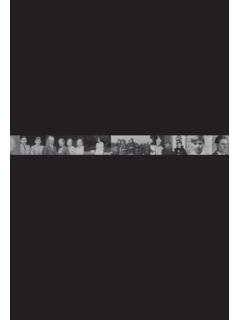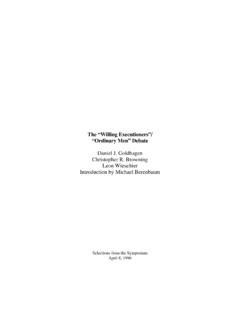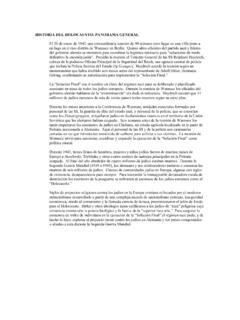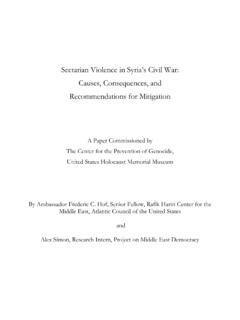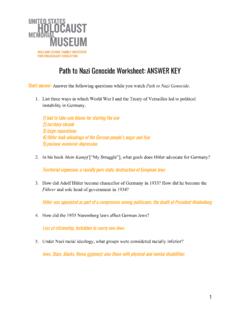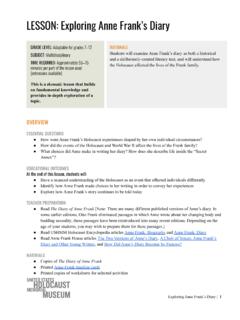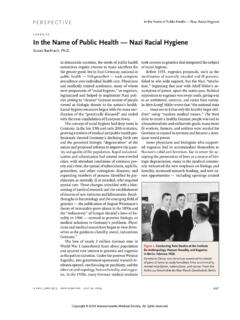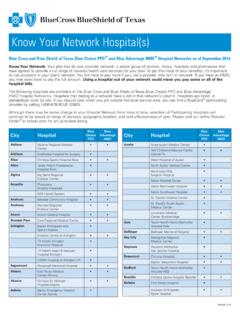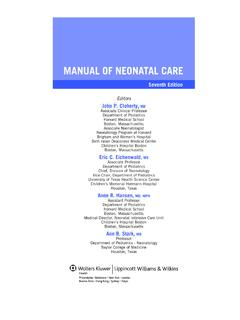Transcription of CHRONOLOGY OF THE HOLOCAUST - United States …
1 CHRONOLOGY OF THE HOLOCAUST29 CHRONOLOGY OF THE HOLOCAUSTJANUARY 30, 1933 German President Paul von Hindenburg appointed Adolf Hitler chancellor. At the time, Hitler wasleader of the National Socialist German Workers Party (Nazi party).FEBRUARY 27 28, 1933 The German parliament (Reichstag) building burned down under mysterious circumstances. Thegovernment treated it as an act of 28, 1933 Hitler convinced President von Hindenburg to invoke an emergency clause in the WeimarConstitution. The German parliament then passed the Decree of the Reich President for theProtection of Nation (Volk) and State, popularly known as the Reichstag Fire Decree.
2 The decreesuspended the civil rights provisions in the existing German constitution, including freedom ofspeech, assembly, and press, and formed the basis for the incarceration of potential opponents of theNazis without benefit of trial or judicial 22, 1933 The SS (Schutzstaffel), Hitler s elite guard, established a concentration camp outside the town ofDachau, Germany, for political opponents of the regime. It was the only concentration camp toremain in operation from 1933 until 1945. By 1934, the SS had taken over administration of theentire Nazi concentration camp 23, 1933 The German parliament passed the Enabling Act, which empowered Hitler to establish a dictator-ship in 1, 1933 The Nazis organized a nationwide boycott of Jewish-owned businesses in Germany.
3 Many localboycotts continued throughout much of the 7, 1933 The Nazi government passed the Law for the Restoration of the Professional Civil Service, whichexcluded Jews and political opponents from university and governmental positions. Similar lawsenacted in the following weeks affected Jewish lawyers, judges, doctors, and 10, 1933 Nazi party members, students, teachers, and others burned books written by Jews, political oppo-nents of Nazis, and the intellectual avant-garde during public rallies across 14, 1933 The Nazi government enacted the Law on the Revocation of Naturalization, which deprivedforeign and stateless Jews as well as Roma (Gypsies)
4 Of German Nazi government enacted the Law for the Prevention of Offspring with Hereditary Diseases,which mandated the forced sterilization of certain physically or mentally impaired law institutionalized the eugenic concept of life undeserving of life and provided the basis forthe involuntary sterilization of the disabled, Roma (Gypsies), social misfits, and black peopleresiding in 30 JULY 1, 1934In what came to be called the Night of the Long Knives, on Hitler s orders members of the Naziparty and police murdered members of the Nazi leadership, army, and others.
5 Hitler declared thekillings legal and necessary to achieve the Nazi party s murders were reported throughoutGermany and in other 2, 1934 German President von Hindenburg died. Hitler became F hrer in addition to his position as chan-cellor. Because there was no legal or constitutional limit to Hitler s power as F hrer, he becameabsolute dictator of 7, 1934In standardized letters sent to the government, Jehovah s Witness congregations from all overGermany declared their political neutrality but also affirmed defiance of Nazi restrictions on thepractice of their 1, 1935 The Nazi government banned the Jehovah s Witness organization.
6 The Nazis persecuted Jehovah sWitnesses because of their religious refusal to swear allegiance to the ABOUT THE HOLOCAUST30 JUNE 28, 1935 The German Ministry of Justice revised Paragraphs 175 and 175a of the criminal code to criminalizeall homosexual acts between men. The revision provided the police broader means for prosecutinghomosexual 15, 1935 The Nazi government decreed the Reich Citizenship Law and the Law for the Protection of theGerman Blood and Honor. These Nuremberg racial laws made Jews second-class citizens. Theyprohibited sexual relations and intermarriage between Jews and persons of German or relatedblood.
7 The Nazi government later applied the laws to Roma (Gypsies) and to black people residingin 12, 1936 Prisoners and civilian workers began construction of the concentration camp Sachsenhausen atOranienburg near Berlin. By September, German authorities had imprisoned about 1,000 people inthe 1 16, 1936 Athletes and spectators from countries around the world attended the Summer Olympic Games inBerlin, Olympic Games were a propaganda success for the Nazi Nazis madeevery effort to portray Germany as a respectable member of the international community and soft-pedaled their persecution of the Jews.
8 They removed anti-Jewish signs from public display andrestrained anti-Jewish activities. In response to pressure from foreign Olympic delegations, Germanyalso included Jews or part-Jews on its Olympic 12 13, 1938 German troops invaded Austria, and Germany incorporated Austria into the German Reich in whatwas called the 6 15, 1938 Delegates from 32 countries and representatives from refugee aid organizations attended the EvianConference at Evian, France, to discuss immigration quotas for refugees fleeing Nazi , the United States and most other countries were unwilling to ease their OF THE HOLOCAUST31 SEPTEMBER 30, 1938 Britain, France, Italy.
9 And Germany signed the Munich Pact, forcing Czechoslovakia to cede itsborder areas to the German 1 10, 1938 German troops occupied the Sudetenland in Czechoslovakia under the stipulations of theMunich 9 10, 1938In a nationwide pogrom called Kristallnacht( Night of Broken Glass ), the Nazis and their collabo-rators burned synagogues, looted Jewish homes and businesses, and killed at least 91 Jews. TheGestapo, supported by local uniformed police, arrested approximately 30,000 Jewish men andimprisoned them in the Dachau, Sachsenhausen, Buchenwald, and Mauthausen concentrationcamps.
10 Several hundred Jewish women also were imprisoned in local 14, 1939 Slovakia declared itself an independent state under protection of Nazi 15, 1939 German troops occupied the Czech lands and established the Protectorate of Bohemia and 13 JUNE 17, 1939 Cuba and the United States refused to accept more than 900 refugees almost all of whom wereJewish aboard the ocean liner St. Louis,forcing its return to 23, 1939 The Soviet and German governments signed the Molotov-Ribbentrop Non-Aggression Pact inwhich they agreed to divide up eastern Europe, including Poland; the Baltic States of Lithuania,Estonia, and Latvia.
